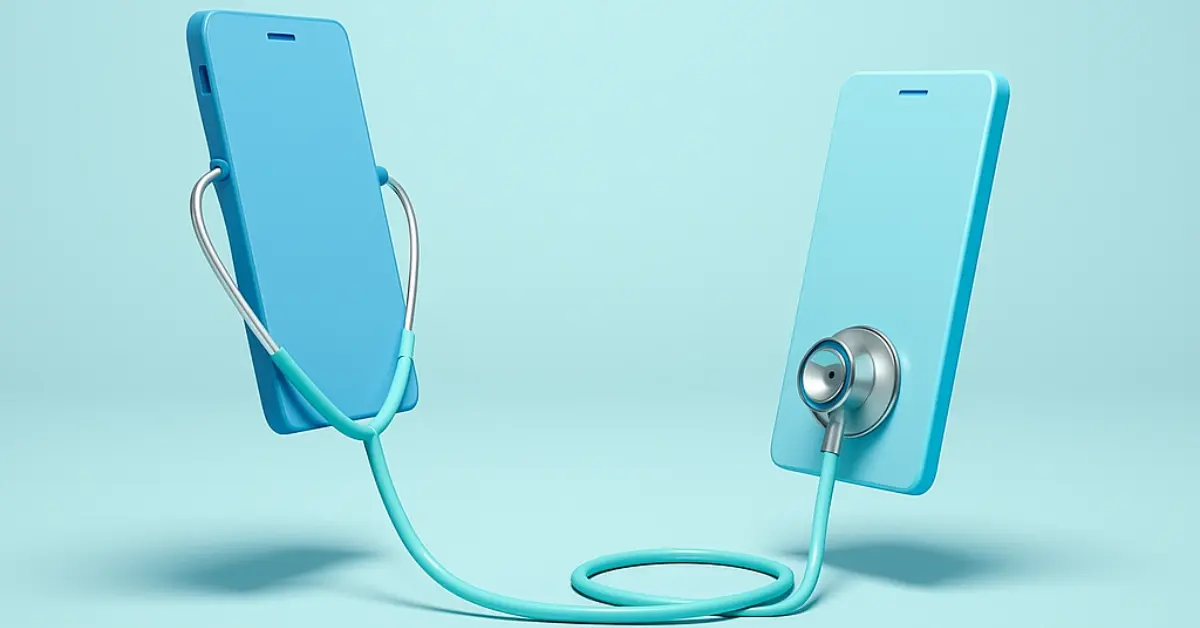Virtual Healthcare and Telehealth: The Future of Medical Consultations
In recent years, the healthcare industry has undergone a significant transformation, with virtual healthcare and telehealth emerging as pivotal components of modern medical practice. These terms, often used interchangeably, encompass a range of services that leverage technology to deliver care remotely. Understanding their nuances is essential for both healthcare providers and patients navigating this evolving landscape.
Table of contents
- Defining virtual healthcare and telehealth
- Telehealth vs. virtual care
- Digital consultations in healthcare
- Virtual health platforms
- Why virtual healthcare matters now
- Virtual capabilities in global healthcare
- Innovative forms of treatment
- Conclusion
Defining virtual healthcare and telehealth
Virtual healthcare refers to a broad ecosystem of digital health services that enable healthcare providers and patients to connect and engage remotely. It goes far beyond virtual doctor visits—it also includes administrative communication (such as appointment scheduling or follow-up messaging), patient education, and ongoing monitoring using connected health devices and platforms. The ultimate goal of virtual healthcare is to improve accessibility, streamline care delivery, and boost patient satisfaction and outcomes through convenient, tech-driven interactions.
In this model, patients can receive advice, track their health, and stay in contact with professionals without needing to visit a clinic or hospital in person. Whether through a patient portal, mobile health app, or AI-assisted symptom checker, virtual care in healthcare is becoming a core part of modern service delivery—especially for those with chronic illnesses or living in remote areas.
Telehealth, by contrast, is a more specific term that falls under the broader umbrella of virtual healthcare. It refers specifically to the use of telecommunication technologies and electronic information systems to deliver long-distance clinical services. These include real-time video consultations, remote patient monitoring, digital transmission of diagnostic images or data (known as store-and-forward), and even mobile health applications that provide tailored medical advice or reminders.
While some still use "telehealth" and "virtual health" interchangeably, it’s important to recognise that virtual healthcare is the more comprehensive term, encompassing telehealth as well as non-clinical digital interactions that improve the overall healthcare journey.
By understanding this distinction, organisations and patients alike can better navigate the expanding world of virtual healthcare services and choose the right tools and platforms for their needs
Virtual care in healthcare
Virtual care in healthcare is a transformative, patient-centred approach that leverages digital technologies to deliver consistent, high-quality care beyond the walls of traditional medical facilities. Unlike episodic in-person visits, virtual care focuses on continuous engagement, making it easier for patients to stay connected with healthcare providers throughout their treatment journey.
This model encompasses a wide array of services, including virtual consultations, remote patient monitoring, and digital therapeutics. These tools work together to support proactive, data-driven care that adapts to a patient’s needs in real-time. For example, individuals managing chronic conditions such as diabetes, hypertension, or asthma can now use wearable devices or smart medical equipment to track vital signs like blood sugar levels, heart rate, or blood pressure from home.
These health metrics are automatically transmitted to care teams via secure digital platforms, enabling clinicians to identify trends, flag warning signs early, and make timely interventions. This kind of digital consultation in healthcare helps reduce the burden on emergency rooms and outpatient services, while empowering patients to take an active role in managing their own health.
Moreover, virtual healthcare services offer increased convenience and accessibility—particularly for elderly patients, individuals in rural or underserved areas, or those with mobility challenges. With features like video check-ins, asynchronous messaging, and symptom tracking apps, virtual care bridges the gap between appointments and ensures patients are never left without support.
As healthcare providers strive to improve outcomes and reduce operational costs, virtual care is quickly becoming a core component of healthcare delivery models worldwide. It exemplifies the shift towards value-based care, where prevention, personalisation, and digital innovation drive better long-term health.

Telehealth vs. virtual care
Though often used interchangeably, telehealth and virtual care are distinct concepts within the digital health landscape. Understanding the differences between them is essential for healthcare professionals, patients, and medical technology providers aiming to implement or access remote care solutions effectively.
Telehealth refers specifically to the use of telecommunication technologies to deliver clinical services from a distance. These are typically real-time interactions, such as a GP video call or a remote mental health consultation. It’s most commonly associated with virtual doctor visits, telepsychiatry, and other direct-to-patient clinical engagements. Telehealth may also include diagnostic services delivered remotely, such as sharing lab results or X-rays for off-site review.
Virtual care, on the other hand, encompasses telehealth but extends far beyond it. It includes all digitally enabled healthcare interactions—both clinical and non-clinical. That means patient education, automated follow-ups, medication reminders, chat-based triage, and even digital therapeutics delivered via apps fall under the umbrella of virtual care. In essence, telehealth is one tool within the much larger virtual care toolbox.
Here’s a side-by-side comparison to make the distinction even clearer:
| Feature | Telehealth | Virtual care |
|---|---|---|
| Scope | Narrow – focused on clinical services | Broad – includes clinical and non-clinical services |
| Main focus | Real-time medical consultations | Ongoing patient engagement and care coordination |
| Examples | Video doctor visits, remote diagnosis | Health education, digital prescriptions, automated follow-ups |
| Communication channels | Video, phone, live chat | Video, phone, chat, mobile apps, wearable integration |
| Use case | Treating immediate clinical needs | Supporting long-term health and wellness |
| Patient interaction | Typically synchronous (live sessions) | Synchronous and asynchronous (messaging, alerts, etc.) |
| Technology requirement | Basic teleconferencing tools | Integrated digital health platforms and mobile health apps |
| Strategic value | Reduces need for in-person visits | Drives long-term outcomes and care continuity |
By appreciating this distinction, healthcare organisations can better tailor their digital transformation strategies. Implementing both telehealth and broader virtual healthcare services ensures patients receive not just timely care, but also ongoing support and education between visits.
Understanding the difference between telehealth and virtual care also helps medical app development companies and healthcare technology providers build more responsive and inclusive platforms, particularly when integrating innovations like SMART on FHIR or AI-based triage tools into care pathways.
Digital consultations in healthcare
Digital consultations are at the heart of modern virtual care and telehealth strategies, enabling healthcare professionals to connect with patients in real time or asynchronously using digital tools. These consultations can take many forms—video calls, phone conversations, or secure messaging through apps or patient portals—and are often the first point of contact in a virtual care journey.
One of the biggest advantages of digital consultations is convenience. Patients no longer need to travel, take time off work, or wait in crowded waiting rooms to speak to a healthcare provider. With a few clicks, they can receive timely medical advice, request prescription renewals, or discuss ongoing treatment—all from the comfort of their home.
For healthcare systems, digital consultations improve efficiency and reduce strain on physical infrastructure. Clinicians can triage cases more effectively, follow up faster, and even manage more patients in less time. This has proven especially valuable in high-demand scenarios such as flu seasons, pandemics, or in pediatrics field, where swift access to professional input can ease parental concerns and support early intervention.
Moreover, digital consultations support multidisciplinary collaboration. A general practitioner, for instance, can involve a specialist in real-time via video, or quickly share test results and imaging with colleagues across different departments. This seamless integration of care fosters quicker decision-making and better health outcomes.
In rural or underserved areas, where access to specialists may be limited, digital consultations can be life-changing. They bring virtual healthcare services to regions that would otherwise suffer from long travel distances, physician shortages, or delayed care. Combined with virtual health platforms and wearable technology, this approach can form a complete virtual care loop—from initial consultation to ongoing management and monitoring.
In a global context, virtual consultation in healthcare is also a critical component in expanding virtual capabilities in global healthcare systems. It offers scalable solutions to workforce shortages, urban overcrowding, and the rising demand for personalised, accessible medical support.
Virtual health platforms
The effectiveness of virtual healthcare and telehealth hinges on robust virtual health platforms—secure, interoperable systems that serve as the digital infrastructure for delivering care remotely. These platforms bring together critical functionalities such as appointment scheduling, electronic health record (EHR) access, secure video consultations, chat-based communication, e-prescribing, and integration with wearable devices and health tracking tools.
More than just a collection of tools, these platforms create a seamless digital experience that enables healthcare providers to coordinate care efficiently while offering patients a more accessible and user-friendly way to engage with medical services. Whether it's a virtual follow-up with a consultant or remote monitoring of chronic conditions, the platform behind the scenes is what makes it all possible.
In Europe, the importance of data security and privacy cannot be overstated. With GDPR compliance as a fundamental requirement, virtual health platforms operating across the EU must ensure end-to-end encryption, secure user authentication, and data hosting within the European Economic Area (EEA). This regulatory environment has given rise to privacy-focused virtual care platforms, some of which are nationally supported—like Sweden’s 1177 Vårdguiden or Denmark’s Sundhed.dk, which enable citizens to book appointments, access test results, and consult doctors securely online.
Private digital health providers are also innovating rapidly. Across Germany, France, and the UK, startups and medical app development companies are building scalable platforms that serve specialties like mental health, chronic care, and even paediatrics. These platforms often include features such as AI-based triage, digital consultations, and integrations with electronic prescriptions and pharmacies—helping to reduce wait times and streamline patient journeys.
To ensure clinical data flows securely between systems, some platforms are built to support modern health IT standards like smart on FHIR, enabling smooth integration with national health records and third-party apps. While not always visible to patients, this behind-the-scenes compatibility plays a vital role in ensuring continuity of care across different providers and services.
Ultimately, virtual health platforms are a cornerstone of digital transformation in healthcare. As technology advances, these platforms will continue to unlock innovative forms of treatment, empower patients with personalised care, and enable healthcare systems to operate more sustainably and efficiently.
Why virtual healthcare matters now
The urgency of adopting virtual healthcare has never been greater. Amid rising healthcare costs, staffing shortages, and the long-term impact of global health crises like the COVID-19 pandemic, healthcare systems are under immense pressure to deliver more care with fewer resources. Virtual capabilities in global healthcare offer a much-needed solution—one that not only expands access but also improves outcomes and operational efficiency.
One of the most compelling advantages of virtual healthcare is its ability to bridge the care gap for patients living in rural or underserved areas. In regions where hospitals or specialists may be hours away, virtual consultations in healthcare eliminate the need for long journeys, allowing patients to receive timely care from the comfort of home. This is particularly beneficial for elderly individuals, people with mobility challenges, or those managing long-term conditions who require regular check-ins.
In urban environments, virtual care helps ease hospital congestion by reducing unnecessary in-person visits. It streamlines patient triage, enabling clinics to prioritise acute cases while managing routine or follow-up care online. This shift allows health systems to function more efficiently, even in times of extreme demand.
Importantly, virtual healthcare services also unlock innovative forms of treatment that extend beyond the traditional doctor’s office. Digital therapeutics, remote monitoring, and personalised care pathways driven by real-time data allow providers to deliver proactive and preventive care. Patients can now be supported continuously between appointments, with early interventions triggered automatically when health data shows concern.
In the paediatrics field, virtual healthcare is already making a tangible impact. Parents can connect with paediatricians or child health specialists for routine advice, development concerns, or follow-up care—without long waiting times or unnecessary travel. This reduces anxiety, improves child health outcomes, and supports working families juggling busy schedules.
Other areas of care have seen dramatic improvements, too. Mental health services have become more accessible through secure video sessions and digital counselling platforms, reaching people who may have otherwise avoided or delayed seeking help. Similarly, chronic disease management has been transformed by remote monitoring tools and virtual care plans that keep patients engaged in their own health journey, with oversight from clinicians.
In short, virtual healthcare is no longer a futuristic add-on—it is a core component of modern care delivery. It empowers healthcare professionals, enhances the patient experience, and strengthens health systems globally.

Virtual capabilities in global healthcare
As healthcare systems across the globe face growing pressure to deliver more with less, virtual capabilities in global healthcare are helping close the gap. From national telemedicine strategies to digital-first clinics, virtual care is reshaping the way services are accessed, coordinated, and delivered worldwide.
In low- and middle-income countries, mobile-based virtual care platforms have expanded access to medical consultations in regions where physical infrastructure is limited. In Europe, countries like Estonia and Finland are leading with digital health records and integrated eHealth services that support nationwide virtual consultations, prescription renewals, and lab result sharing—all available online to patients.
Meanwhile, global health organisations are increasingly turning to virtual care to strengthen emergency preparedness and pandemic resilience. Digital tools enable remote triage, virtual training of health workers, and rapid dissemination of public health messaging—all critical in times of crisis.
Virtual care is not only filling care gaps—it’s establishing new care pathways for patients in even the most remote or underserved regions. As technology adoption increases, global virtual health capabilities are laying the foundation for a more equitable, connected future in healthcare.
Innovative forms of treatment
Beyond convenience, virtual healthcare is driving innovation in how care is delivered and experienced. New technologies are enabling treatments that were once impossible outside a hospital setting.
Remote patient monitoring allows individuals with chronic diseases—like heart failure or COPD—to be tracked in real-time using connected devices. When abnormalities are detected, alerts can trigger clinician intervention before conditions worsen.
Meanwhile, digital therapeutics—clinically validated software tools—are being used to treat conditions ranging from insomnia and depression to diabetes and ADHD, all without a traditional prescription. Patients interact with apps that deliver behavioural therapy, monitor progress, and adjust treatment dynamically based on usage and outcome data.
In rehabilitation and mental health, virtual reality (VR) is opening up immersive treatment possibilities, while AI-driven chatbots provide 24/7 support for patients managing anxiety or addiction. These innovative forms of treatment not only increase access, but also improve outcomes through personalisation and continuous feedback.
As the healthcare landscape evolves, the combination of virtual platforms and emerging technologies will define the next era of medicine—one where digital consultation in healthcare is just the beginning of a much broader transformation.
Conclusion
As healthcare continues to evolve, virtual care and telehealth are no longer optional—they are essential. These technologies enable providers to reach patients wherever they are, deliver higher-quality care more efficiently, and support healthier populations with fewer barriers.
Whether it's a digital consultation with a GP, remote chronic disease monitoring, or on-demand access to a mental health specialist, virtual healthcare services are unlocking a new standard of care that is flexible, accessible, and sustainable. As the industry shifts towards patient-first models, the platforms and APIs behind the scenes are just as crucial as the care itself.
That’s where Digital Samba comes in.
Digital Samba offers a feature-rich video conferencing API and SDK designed specifically for secure, high-quality virtual healthcare experiences. Easily embedded into any app or healthcare platform, it enables developers and providers to build custom, GDPR-compliant video consultations that fit seamlessly into clinical workflows.
Contact our sales team to explore enterprise-grade options tailored for your healthcare solution.
FAQs
Virtual healthcare refers to the use of digital technology to provide medical services remotely. This includes video consultations, digital prescriptions, remote monitoring, and patient education tools.
Virtual care is a broad term encompassing both clinical and non-clinical interactions between patients and providers using digital platforms. It includes telehealth services, app-based follow-ups, symptom checkers, and more.
Not exactly. Telehealth is a part of virtual healthcare that focuses on remote clinical services like video consultations. Virtual healthcare is broader and includes administrative, educational, and preventative digital tools.
Digital consultations allow patients to speak to doctors or specialists using secure video, phone, or chat systems. They offer convenience, quicker access to care, and better follow-up between visits.
Telehealth focuses mainly on delivering real-time clinical services remotely. Virtual care includes telehealth but also covers asynchronous communication, digital follow-ups, and patient engagement tools.
Platforms like Digital Samba offer high-definition, secure, and customisable video integrations that can be embedded into healthcare apps or portals—ideal for providers looking to offer seamless virtual care.
Share this
You May Also Like
These Related Stories

Future of Telehealth: Key Trends Transforming Virtual Healthcare
.png)
The future of virtual healthcare

